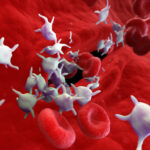 As we know, myeloproliferative neoplasms (MPNs) are a group of blood cancers that involve the overproduction of blood cells in the bone marrow. These conditions primarily include polycythemia vera (PV), essential thrombocythemia (ET), and myelofibrosis (MF). One of the primary features of certain MPNs, particularly essential thrombocythemia, is the abnormal production and function of platelets, that help with blood clotting and maintaining vascular integrity. Understanding the relationship between platelets and MPNs is crucial for diagnosing,
As we know, myeloproliferative neoplasms (MPNs) are a group of blood cancers that involve the overproduction of blood cells in the bone marrow. These conditions primarily include polycythemia vera (PV), essential thrombocythemia (ET), and myelofibrosis (MF). One of the primary features of certain MPNs, particularly essential thrombocythemia, is the abnormal production and function of platelets, that help with blood clotting and maintaining vascular integrity. Understanding the relationship between platelets and MPNs is crucial for diagnosing,
monitoring, and managing these disorders.
What Are Platelets?
Platelets, also known as thrombocytes, are small, disc-shaped cell fragments in the blood. Produced in the bone marrow by megakaryocytes, platelets are essential for hemostasis—the process that prevents excessive bleeding when blood vessels are injured. When a blood vessel is
damaged, platelets adhere to the site of injury, coagulate to form a plug, and interact with clotting factors to stabilize the clot, preventing further blood loss.
How Do Platelets Work In MPNs?
In MPNs, the bone marrow exhibits uncontrolled proliferation of hematopoietic stem cells, leading to the overproduction of various blood cells, including platelets. This dysregulation can significantly impact platelet function and count, resulting in both hemorrhagic and thrombotic complications.
Platelets in Essential Thrombocythemia (ET)
Essential thrombocythemia is characterized by an excessive production of platelets due to mutations in genes such as JAK2, CALR, or MPL. In ET:
● High Platelet Counts: Patients often present with elevated platelet counts, sometimes exceeding one million platelets per microliter of blood. Despite the abundance of platelets, they may not function normally, leading to an increased risk of clotting (thrombosis) and bleeding (hemorrhage).
● Thrombotic Risk: Abnormally high platelet counts increase the likelihood of clot formation within blood vessels, potentially leading to complications such as stroke, heart attack, deep vein thrombosis (DVT), and pulmonary embolism.
● Bleeding Risk: Interestingly, patients with extremely high platelet counts can also experience bleeding issues. This is because the overproduction of platelets can lead to a depletion of von Willebrand factor (vWF), which is necessary for platelet adhesion,
Platelets in Polycythemia Vera (PV)
In PV, there is an overproduction of red blood cells, often accompanied by increased platelets and white blood cells:
● Platelet Dysfunction: Although the platelet count in PV is usually elevated, platelet function can be abnormal. This dysfunction can result in an increased risk of thrombosis even though there is a high platelet count.
● Thrombotic Events: Similar to ET, patients with PV have a higher risk of blood clots because the not only is there an increase in blood viscosity (from elevated red blood cell mass) there is also altered platelet function.
Platelets in Myelofibrosis (MF)
Myelofibrosis is marked by the replacement of bone marrow with fibrous tissue, impairing normal blood cell production:
● Variable Platelet Counts: Patients with MF may have either low (thrombocytopenia) or high (thrombocytosis) platelet counts, depending on disease progression and bone marrow function.
● Abnormal Platelet Function: Regardless of the platelet count, platelet function is often compromised, which leads to a higher risk of both bleeding and clotting events.
Platelets in Diagnosis and Management
The evaluation of platelet count and function is an important part of diagnosing and managing MPNs. Laboratory tests commonly used include:
● Complete Blood Count (CBC): To assess platelet count, red blood cell mass, and white blood cell count.
● Bone Marrow Biopsy: To examine marrow architecture and megakaryocyte proliferation, providing insight into the degree of myeloproliferation.
● Genetic Testing: To identify mutations in JAK2, CALR, and MPL genes, which are associated with different MPNs.
● Platelet Function Tests: In some cases, platelet aggregation studies may be used to evaluate platelet function, especially if bleeding complications are present.
The primary goal in managing MPNs is to minimize the risk of thrombotic and hemorrhagic events. Several treatment strategies are used to address abnormal platelets such as cytoreductive therapies, antiplatelet agents, JAK2 inhibitors, and close monitoring of blood counts.
Platelets play a central role in the diagnosis, progression, and care of myeloproliferative neoplasms. Understanding the complex interactions between platelets and MPNs is crucial for effective diagnosis, risk assessment, and management of these disorders. With appropriate
monitoring and individualized treatment strategies, the risks associated with abnormal platelet activity in MPNs can be managed, improving patient outcomes. For more information about MPNs visit our website at www.mpnadvocacy.com.

